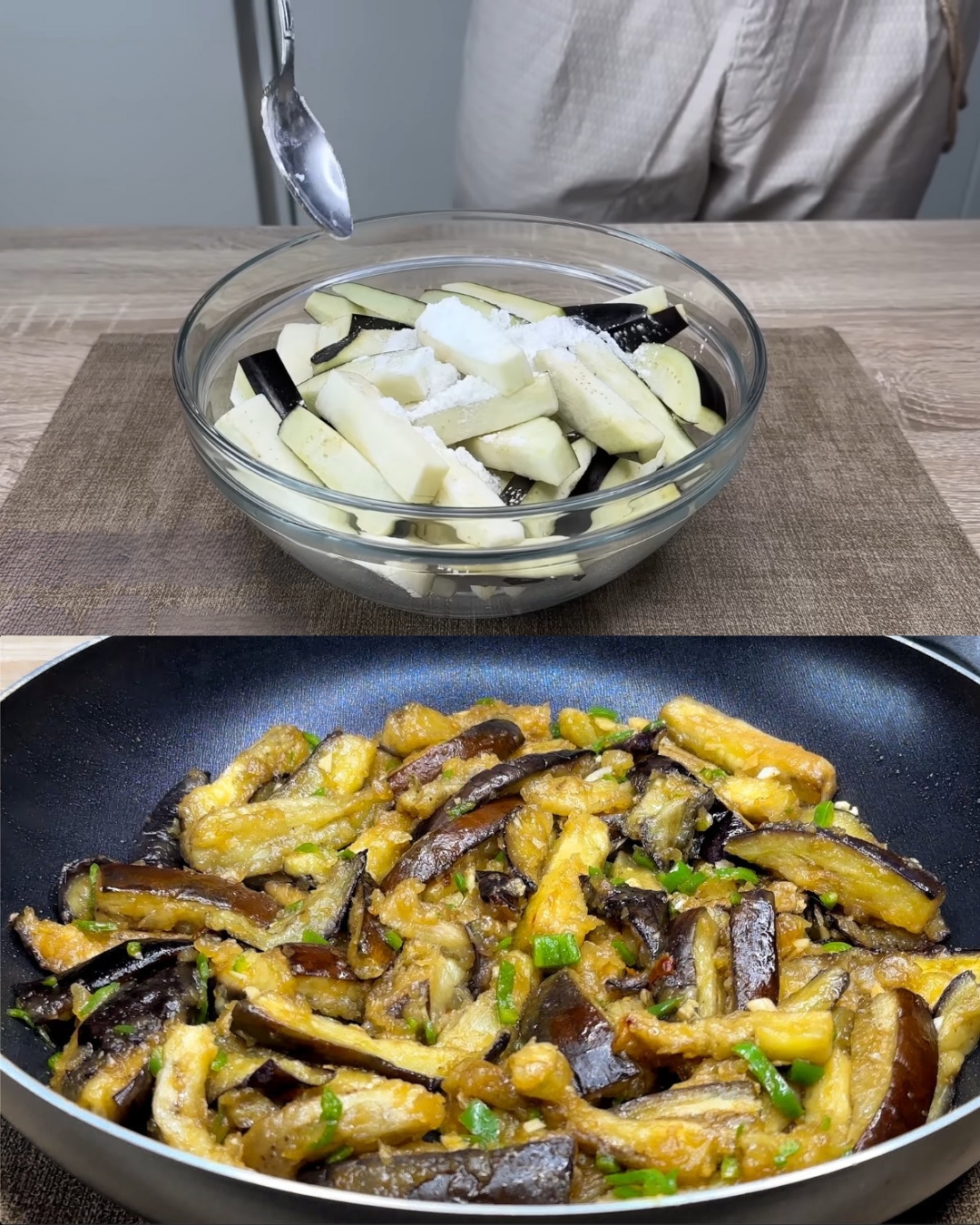Eggplant, with its meaty texture and ability to absorb flavors, makes a perfect canvas for a variety of dishes. This simple yet delicious recipe for sautéed eggplant and pepper in soy sauce brings together the deep, savory flavors of soy with the natural sweetness of peppers and the robustness of eggplant. It’s an excellent dish for those who appreciate quick, flavorful meals that require minimal preparation but deliver maximum taste. Whether served as a side dish or a vegetarian main course, this stir-fry is sure to impress with its balance of sweet and savory notes.
Ingredients:
- 2 eggplants, cut into bite-sized pieces
- 3 cloves of garlic, minced
- 1 small pepper, sliced
- 3-4 tablespoons soy sauce
- Half a teaspoon of sugar
- 1/3 cup of water
- Salt and pepper to taste
- Oil for cooking
Preparation Time:
- Prep Time: 10 minutes
- Cook Time: 15 minutes
- Total Time: 25 minutes
Instructions:
- Sauté: In a large skillet, heat oil over medium heat. Add garlic and fry until fragrant, about 1 minute.
- Cook Vegetables: Add the sliced peppers and eggplant. Stir-fry for about 5 minutes, or until the vegetables begin to soften.
- Season: Mix the soy sauce, sugar, and water in a small bowl. Pour this mixture over the vegetables in the skillet. Stir well to combine and coat the vegetables. Cook for an additional 5 minutes, or until the sauce has thickened and the vegetables are tender. Adjust salt and pepper to taste.
Flavor Variations
- Spicy Kick: For those who enjoy a bit of heat, add a teaspoon of chili flakes or a splash of hot sauce to the soy sauce mixture. You can also incorporate fresh sliced chili peppers when sautéing the garlic for an extra fiery touch.
- Asian Fusion: Introduce a teaspoon of sesame oil and a tablespoon of hoisin sauce or oyster sauce to the soy sauce mixture for a deeper, more complex flavor. Garnishing with toasted sesame seeds and sliced green onions can also enhance this Asian-inspired version.
- Mediterranean Twist: Swap out the soy sauce for a light drizzle of balsamic vinegar and add a sprinkle of dried Italian herbs like oregano and basil during the cooking process. Finish with fresh parsley and a squeeze of lemon juice before serving to brighten the flavors.
- Indian Influence: Add a teaspoon each of ground cumin, coriander, and a pinch of garam masala to the vegetables while they cook. This variation introduces a warm, aromatic flavor typical of Indian cuisine.
- Thai Touch: Incorporate a tablespoon of fish sauce (or keep it vegetarian with a vegan fish sauce alternative) and a teaspoon of brown sugar to the soy sauce mixture. Add a handful of fresh Thai basil leaves towards the end of cooking for a fragrant, Thai-inspired flavor.
- Herb Freshness: Mix in fresh herbs like cilantro, dill, or mint after cooking. Fresh herbs add a refreshing note that contrasts beautifully with the rich, savory elements of the stir-fry.
- Creamy Coconut: For a richer, creamier version, add a splash of coconut milk towards the end of cooking and reduce until thick. This version pairs wonderfully with jasmine rice and adds a tropical flair to the dish.
Nutritional Benefits
This recipe is not only delicious but also packed with nutritional advantages:
- Eggplant: A great source of fiber, vitamins B1 and B6, and potassium. It also contains important phytonutrients which have antioxidant properties.
- Peppers: Rich in vitamin C, particularly red peppers, which contain more than green peppers. They are also a good source of dietary fiber, vitamin A, and potassium.
- Garlic: Known for its health benefits, including enhancing immune function and reducing blood pressure.
- Soy Sauce: Provides important minerals like magnesium and potassium but should be used in moderation due to its high sodium content.
Dietary Information
This dish is inherently vegan and gluten-free, provided that gluten-free soy sauce is used. It’s an excellent choice for those following plant-based diets looking for dishes rich in vegetables and flavors.
Cooking Tips
- Balancing Flavors: The key to this dish is balancing the savory depth of the soy sauce with the natural sweetness of the peppers and the mild bitterness of the eggplant. Adjust the amount of sugar based on the brand of soy sauce and your taste preference to achieve a harmonious flavor balance.
- Texture is Key: To avoid soggy eggplant, ensure the skillet is hot before adding the vegetables. This helps to sear the eggplant and lock in flavors.
- Variations: Feel free to add other vegetables like zucchini, mushrooms, or onions to the stir-fry to add different textures and flavors. Tofu or tempeh can be included to make this dish more substantial.
Serving Suggestions
While this dish can be served on its own or with steamed rice for a simple meal, it also pairs wonderfully with other dishes:
- With Protein: Serve alongside grilled chicken or fish for a non-vegetarian meal or add tofu for a vegetarian protein boost.
- In a Bowl: Make it part of a ‘bowl’ meal with quinoa or brown rice, adding a drizzle of sesame oil and a sprinkle of sesame seeds for extra flavor and crunch.
- As a Side: This stir-fry makes a colorful and flavorful side dish to accompany more neutral main dishes, like baked or roasted meats.


